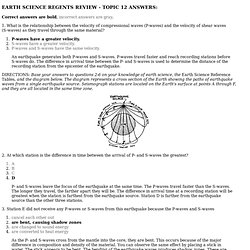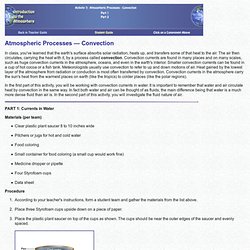

Why is it Hot Underground? Heat Transfer. EARTH SCIENCE REGENTS REVIEW - TOPIC 12 ANSWERS. Correct answers are bold, incorrect answers are gray. 1.

What is the relationship between the velocity of compressional waves (P-waves) and the velocity of shear waves (S-waves) as they travel through the same material? P-waves have a greater velocity. S-waves have a greater velocity. Convection: a fun, at-home science experiment. Earthguide.ucsd.edu/eoc/teachers/t_tectonics/seafloor_spreading.swf. MODEL OF SEA-FLOOR SPREADING. Purpose: Students will make a paper model illustrating the concept of sea-floor spreading and the development of symmetrical magnetic "stripes" on either side of a mid- ocean spreading center.

Suggested Student Grouping: Students work as individuals. Framework Integration: Themes: Patterns of change: over time, new sea-floor is created by the upwelling of magma at mid-ocean spreading centers; old ocean floor is destroyed by subduction at deep sea trenches. Science skills and processes: Inferring from a model. Integrating with other disciplines: Physical science: dipole magnets and magnetic fields; convection. Seafloor spreading. Www.amnh.org/learn/pd/earth/pdf/mantle_convection.pdf. Www.amnh.org/learn/pd/earth/pdf/mantle_convection.pdf. AQA Core Science Convection. CONVECTION WITH THE SCIENCE GEEKS. Convection Demos. Convection%20Currents%20lab.pdf. Lab Demo Comparing Heat Transfer by Convection and Conduction.
Dale Durran and Yaga Beres Purpose: To compare two methods of heat transfer in the atmosphere: convection and conduction Equipment: Two tall cylindrical beakers, water, food coloring, 2 salsa containers, a short piece of metal chain.

Early Preparation: The metal chain is placed in one salsa container. Procedure: 1) Two tall beakers, A and B, are filled with hot water (3/4 full only). 2) Ice chunks are taken out of the salsa containers and carefully placed in the tall beakers: The ice with chain in Beaker A; the ice without chain in Beaker B. What happens? Explanation: Warm water is more buoyant than cold water. In Beaker A, on the other hand, the warm buoyant water overlays the cold ice. Conclusion: In fluids, such as water and air, convection is a much more efficient method of heat transfer than conduction. Related Links: YouTube Video Polish Translation courtesy of Maksim Ivancov. Some unanswered questions [This Dynamic Earth, USGS] The tectonic plates do not randomly drift or wander about the Earth's surface; they are driven by definite yet unseen forces.
![Some unanswered questions [This Dynamic Earth, USGS]](http://cdn.pearltrees.com/s/pic/th/unanswered-questions-dynamic-80474830)
Although scientists can neither precisely describe nor fully understand the forces, most believe that the relatively shallow forces driving the lithospheric plates are coupled with forces originating much deeper in the Earth. What drives the plates? From seismic and other geophysical evidence and laboratory experiments, scientists generally agree with Harry Hess' theory that the plate-driving force is the slow movement of hot, softened mantle that lies below the rigid plates. This idea was first considered in the 1930s by Arthur Holmes, the English geologist who later influenced Harry Hess' thinking about seafloor spreading. Convection: a fun, at-home science experiment. Activity 7 Student Guide: Atmospheric Processes - Convection. In class, you've learned that the earth's surface absorbs solar radiation, heats up, and transfers some of that heat to the air.

The air then circulates, carrying the heat with it, by a process called convection. Convection currents are found in many places and on many scales, such as huge convection currents in the atmosphere, oceans, and even in the earth's interior. Smaller convection currents can be found in a cup of hot cocoa or a fish tank. Meteorologists usually use convection to refer to up and down motions of air. Heat gained by the lowest layer of the atmosphere from radiation or conduction is most often transferred by convection.
In the first part of this activity, you will be working with convection currents in water. PART 1: Currents in Water Materials (per team) Procedure According to your teacher's instructions, form a student team and gather the materials from the list above. Fill the plastic saucer three-quarters full with cool water. Variations. How To Make a Simple Lava Lamp At Home. HOW TO MAKE A HOMEMADE LAVA LAMP!!! How Does It Work? - Lava Lamps. Why is the earth's core so hot? And how do scientists measure its temperature? Quentin Williams, associate professor of earth sciences at the University of California at Santa Cruz offers this explanation: There are three main sources of heat in the deep earth: (1) heat from when the planet formed and accreted, which has not yet been lost; (2) frictional heating, caused by denser core material sinking to the center of the planet; and (3) heat from the decay of radioactive elements.

CROSS SECTION shows Earth's structure. It takes a rather long time for heat to move out of the earth. This occurs through both "convective" transport of heat within the earth's liquid outer core and solid mantle and slower "conductive" transport of heat through nonconvecting boundary layers, such as the earth's plates at the surface. As a result, much of the planet's primordial heat, from when the earth first accreted and developed its core, has been retained. Why is the Center of the Earth Hot. Want to stay on top of all the space news?

Follow @universetoday on Twitter Earth's core.